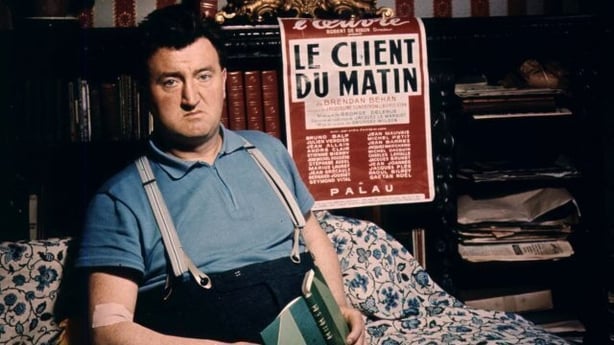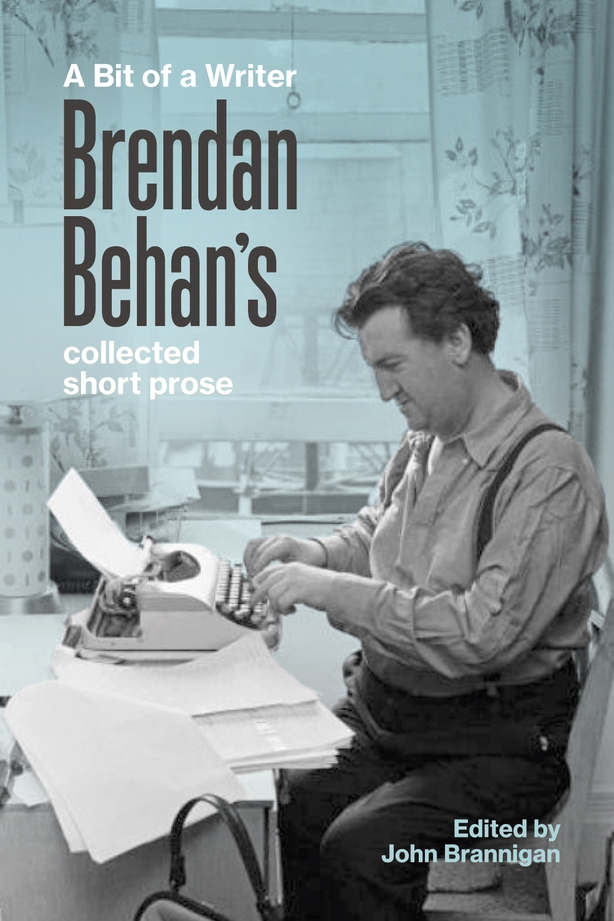Brendan Behan wrote over one hundred articles for Irish newspapers between 1951 and 1956 as he rose to international fame, with most of them written in a weekly column in the Irish Press. The articles reveal a serious writer capable of great comic set pieces and amusing yarns as well as thoughtful reflections on cultural and historical issues.
Below, editor John Brannigan introduces A Bit of a Writer: Brendan Behan's Collected Short Prose, his new collection for Lilliput Press gathering all the articles and essays that Behan published in newspapers from 1951 to his death in 1964.
Before Brendan Behan became famous internationally as a playwright and bohemian reveller, he wrote a weekly newspaper column in Dublin for The Irish Press. Between 1953 and 1956 he produced over one hundred articles. Some were recollections of his childhood in Northside Dublin, some were inventive comic fictions, some told the stories of his travels and musings around Ireland and Europe. He had begun to write these articles on an occasional basis in 1951, but they became a regular feature in late 1953 when the new editor, Jim McGuinness, commissioned him to write a weekly column. McGuinness had known Behan in the 1940s – both men were interned in the Curragh military camp as IRA activists during the Second World War. When he became editor of The Irish Press, McGuinness set out to bring more writers to the newspaper for feature articles and columns. It is evidence of the impact that Behan had already had as a young writer that McGuinness chose to ask him alongside more established writers such as Lennox Robinson and Francis MacManus. By this time, Behan had published a handful of short stories in English, and some poems in Irish, as well as a serialized novel, The Scarperer, which was published under a pseudonym, 'Emmet Street’, in The Irish Times. He had also written radio plays and presented radio broadcasts for Raidió Éireann. In 1954 his first major play, The Quare Fellow, had its premiere in Dublin’s Pike Theatre; by 1956 the play had made him an international star. The columns published in The Irish Press were written in the period in which Behan achieved his first success, and in which he was at his most confident and conscientious as a writer.
In later years, wracked with illness, Behan seemed to resent the fact that Dubliners were slow to recognize his talents.
‘Brendan wrote his newspaper articles with ease,’ wrote his wife, Beatrice, ‘rarely missing a deadline.’ He was paid five pounds a week and given free rein to write about whatever he chose. He rose early, and would write until it was time to bring Beatrice breakfast in bed. It was a routine not completely without interruptions, for he would occasionally go off on drinking binges, but he usually found ways of making the deadline. Donal Foley, who worked in the London office of The Irish Press, recalled how Behan turned up at the office one day to ask for an advance of twenty pounds. The editor allowed Foley to give Behan the money on condition that he first received four articles. Four hours later Behan returned with four articles amounting to seven thousand words, and was paid the money. Behan’s column, Foley writes, was ‘the best of its kind to appear anywhere at that time’, and the four articles, hastily written as they were, lived up to expectations.

In later years, wracked with illness, Behan seemed to resent the fact that Dubliners were slow to recognize his talents. His most significant achievements in literature found success and recognition elsewhere. The Quare Fellow was rejected by the Abbey Theatre and performed only in the Pike, a small experimental theatre, before it became an international success after its West End production in London in 1956. The Hostage first found expression in an Irish-language version, An Giall, performed in the modest setting of Damer Hall in Dublin, but then likewise became a West End and Broadway success in 1958. Borstal Boy, his autobiographical novel, was banned in Ireland as soon it was published in the same year. Lionized by theatre audiences in England, America and Europe, and courted by journalists and broadcasters wherever he went, Behan felt shunned by his peers in Ireland. In an interview with Eamonn Andrews, broadcast on RTÉ in 1960, Behan’s resentment was palpable: ‘The Irish are not my audience; they are my raw material,’ he professed. When Andrews asked if he would like the Irish to be his audience, Behan replied, ‘No, I don’t care. I don’t care.’
Behan did care. In the articles gathered here, it is clear that he cared deeply about Dublin and Dubliners. He cherished the stories, songs and sayings of the people who surrounded him in his childhood and youth. There is a prevailing sense of nostalgia for the receding generations and communities of the early twentieth century – the rebels of 1916, the veterans of the Boer War and the First World War, and the oul’ ones whose sharp wit and quick tongues deflated the pomposity of both the rebels and the veterans. There is also a lively sense of community with contemporary Dubliners – Behan has much to say about changes in the city, and responds to his correspondents in his column. Behan attempted to produce in his column a sense of Dublin as a ‘knowable community’, a place that abounded with jovial rivalries between distinct areas (‘Monto’ and the ‘Coombe’; the Northside and the Southside), but ultimately a city in which it was impossible to get lost. In his comic sketches, and the characters he invented for them – Mrs Brennan, Maria Concepta, Crippen – he conjured up the distinctive dialectal style and conversational rhythms of Dublin speech, and a strong sense of identity and outlook. ‘The Dubliner is the victim of his own prejudices,’ writes Behan, but in these articles he satirizes those prejudices tirelessly, writing that he had been ‘conditioned all the days of my life to the belief that people from the three other provinces, Cork, the North and the Country, could build nests in your ear, mind mice at a crossroads, and generally stand where thousands fell’.
It is, then, as a ‘jackeen’, a Dubliner seen as if from outside, that Behan also takes his readers on a tour around Ireland – to Wicklow and Wexford, to Kerry, Connemara and the Aran Islands, to Belfast and Donaghadee. These outings are no mere travelogues or tour guides. He is rarely interested in the ‘sights’; instead, Behan displays the same warm curiosity and interest in people and their stories wherever he goes. The same is true of his adventures across the sea to France, and particularly to Paris, a place dear to his heart since the late 1940s. ‘Everyone admires Paris for the artists,’ he wrote, ‘but I equally loved Paris for the barricades.’ In truth, literature and politics are intertwined and inseparable sources of interest for Behan. The pieces abound in allusions to writers and artists, and perhaps even more so to the architects and activists of Irish republicanism. We find in them stories of Brendan Behan passing himself off as George Orwell, and stories about Yeats, Joyce and O’Casey. The pantheon of Irish heroes, from Brian Boru to Patrick Pearse, is never far from his thoughts. Yet perhaps Behan’s greatest gift is to give no more significance or weight to the stories of these famous figures than to the stories of his family and neighbours. Behan was a folk writer, in the best tradition of folk tales and folk songs, a collector and teller of stories.

A Bit of a Writer: Brendan Behan’s Collected Short Prose edited by John Brannigan is published by Lilliput Press - find out more here.

